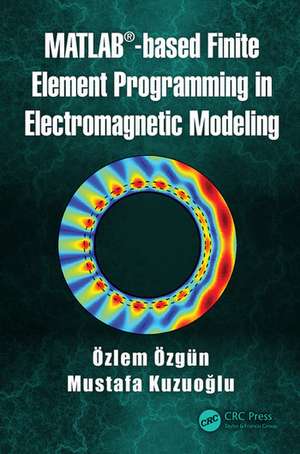MATLAB-based Finite Element Programming in Electromagnetic Modeling
Autor Özlem Özgün, Mustafa Kuzuoğluen Limba Engleză Hardback – 27 sep 2018
This book is a self-contained, programming-oriented and learner-centered book on finite element method (FEM), with special emphasis given to developing MATLAB® programs for numerical modeling of electromagnetic boundary value problems. It provides a deep understanding and intuition of FEM programming by means of step-by-step MATLAB® programs with detailed descriptions, and eventually enabling the readers to modify, adapt and apply the provided programs and formulations to develop FEM codes for similar problems through various exercises. It starts with simple one-dimensional static and time-harmonic problems and extends the developed theory to more complex two- or three-dimensional problems. It supplies sufficient theoretical background on the topic, and it thoroughly covers all phases (pre-processing, main body and post-processing) in FEM. FEM formulations are obtained for boundary value problems governed by a partial differential equation that is expressed in terms of a generic unknown function, and then, these formulations are specialized to various electromagnetic applications together with a post-processing phase. Since the method is mostly described in a general context, readers from other disciplines can also use this book and easily adapt the provided codes to their engineering problems. After forming a solid background on the fundamentals of FEM by means of canonical problems, readers are guided to more advanced applications of FEM in electromagnetics through a survey chapter at the end of the book.
Preț: 886.83 lei
Preț vechi: 1184.74 lei
-25% Nou
Puncte Express: 1330
Preț estimativ în valută:
169.70€ • 177.62$ • 141.24£
169.70€ • 177.62$ • 141.24£
Carte tipărită la comandă
Livrare economică 31 martie-14 aprilie
Preluare comenzi: 021 569.72.76
Specificații
ISBN-13: 9781498784078
ISBN-10: 1498784070
Pagini: 440
Ilustrații: 1 Line drawings, color; 99 Line drawings, black and white; 17 Halftones, color; 2 Halftones, black and white; 74 Tables, black and white; 21 Illustrations, color; 157 Illustrations, black and white
Dimensiuni: 178 x 254 x 27 mm
Greutate: 1.08 kg
Ediția:1
Editura: CRC Press
Colecția CRC Press
ISBN-10: 1498784070
Pagini: 440
Ilustrații: 1 Line drawings, color; 99 Line drawings, black and white; 17 Halftones, color; 2 Halftones, black and white; 74 Tables, black and white; 21 Illustrations, color; 157 Illustrations, black and white
Dimensiuni: 178 x 254 x 27 mm
Greutate: 1.08 kg
Ediția:1
Editura: CRC Press
Colecția CRC Press
Cuprins
Chapter 1 Introduction Chapter 2 MATLAB Primer Chapter 3 Mathematical Fundamentals of FEM Chapter 4 One-Dimensional Finite Element Analysis Chapter 5 Two-Dimensional Finite Element Analysis Chapter 6 Three-Dimensional Finite Element Analysis Chapter 7 Past and Present: A Selected Bibliography
Notă biografică
Özlem Özgün received her B.Sc. and M.Sc. degrees from Bilkent University, Ankara, Turkey in 1998 and 2000, respectively, and her Ph.D. degree from Middle East Technical University (METU), Ankara, Turkey in 2007, all in electrical and electronics engineering. She worked at the Electromagnetic Communication Lab, Penn State University, USA as a postdoctoral researcher during 2007-2008. Currently, she is an associate professor in the electrical and electronics engineering department of Hacettepe University, Ankara, Turkey. Dr. Özgün's research interests include computational electromagnetics, finite element method, domain decomposition methods, transformation electromagnetics/optics, electromagnetic scattering, stochastic electromagnetic problems and optimization techniques. She has published over 100 refereed journal papers, book chapters, and conference articles. Dr. Özgün received METU Ph.D. best thesis award in 2007, and the award for excellence in electromagnetics bestowed by Prof. Leopold B. Felsen Fund in 2009. She is a senior member of IEEE, and a member of the steering committee of URSI Turkey.
Mustafa Kuzuoğlu earned his B.Sc., M.Sc. and Ph.D. degrees from Middle East Technical University (METU) in 1979, 1981 and 1986 respectively, all in electrical and electronics engineering. His Ph.D. thesis is one of the first attempts to apply the finite element method for the numerical solution of electromagnetic scattering problems. Currently, he is a professor at the electrical and electronics engineering department of METU. He has held visiting positions at the University of Illinois at Urbana-Champaign and Pennsylvania State University during the years 1995-2003. Dr. Kuzuoğlu's research interests include computational electromagnetics with special emphasis on the finite element method, electromagnetic scattering, perfectly matched layers, transformation electromagnetics/optics and radar signal processing. He has over 150 refereed publications in the form of journal articles, book chapters and conference proceedings.]
Mustafa Kuzuoğlu earned his B.Sc., M.Sc. and Ph.D. degrees from Middle East Technical University (METU) in 1979, 1981 and 1986 respectively, all in electrical and electronics engineering. His Ph.D. thesis is one of the first attempts to apply the finite element method for the numerical solution of electromagnetic scattering problems. Currently, he is a professor at the electrical and electronics engineering department of METU. He has held visiting positions at the University of Illinois at Urbana-Champaign and Pennsylvania State University during the years 1995-2003. Dr. Kuzuoğlu's research interests include computational electromagnetics with special emphasis on the finite element method, electromagnetic scattering, perfectly matched layers, transformation electromagnetics/optics and radar signal processing. He has over 150 refereed publications in the form of journal articles, book chapters and conference proceedings.]
Descriere
This book focuses on finite element methods with emphasis on MATLAB for numerical modeling of electromagnetic problems. Providing readers with knowledge and skills thorough which they can develop their own finite element codes for practical applications.
